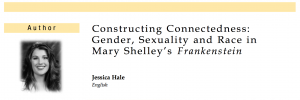In “Constructing Connectedness: Gender, Sexuality and Race in Mary Shelley’s Frankenstein”, Jessica Hale’s main argument is that Shelley used various relationships such as familial, homosocial, sexual, and racial throughout Frankenstein in order to reveal the social issues during that time period. For instance, Jessica Hale argues that Mary Shelly uses the relationship between Alphonse and Caroline as well as Victor and Elizabeth to show how the society at the time favored a traditional domestic family where the wife was typically seen as submissive and weak objects and the husband was seen as a paternal figure. She also argues that Mary Shelley is trying to convey the idea of the society at the time being that domesticity is discordant with dealing with public affairs because it affects the role of the husband. Another argument that Jessica Hale makes is that Victor is narcissistic in that he created the monster in his own image and the monster desire Victor, which is an extreme form of homosocial longing that forces the exclusion of females.
An example of a close reading is on page 21 when Jessica Hale mentions that Victor in the story describes Elizabeth as “a possession of my own”, which is very effective because it clearly shows that women were perceived as objects. Another example of a close reading is when the Jessica Hale mentions that on page 4, Walton “desire[s] the company of a man who could sympathize with [him], whose eyes would reply to [him]” because it directly shows how erotic desire is used to describe the longing for male companionship.
One secondary source that Jessica Hale uses is The Freudian Body which was used to help Jessica Hale use psychoanalytic theory to create this literary criticism as well as helping Jessica Hale formulate ideas from Freud that can help her analyze Frankenstein more effectively.
Some terms that I did not know were psychoanalytic theory, seafaring, mélange, and libidinal. One of the terms, libidinal is relating to sexual desire, and I google searched libidinal in order to get the definition.

